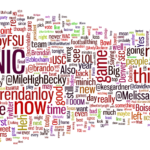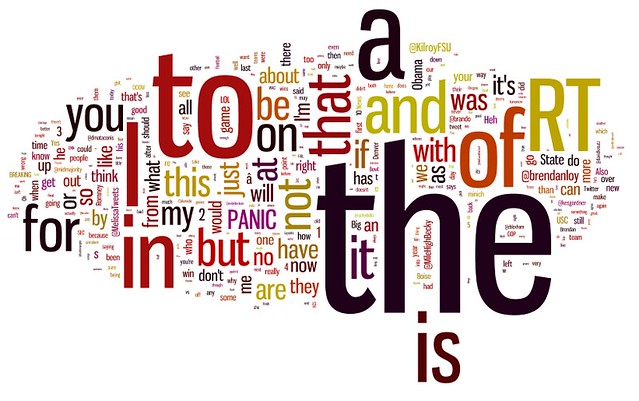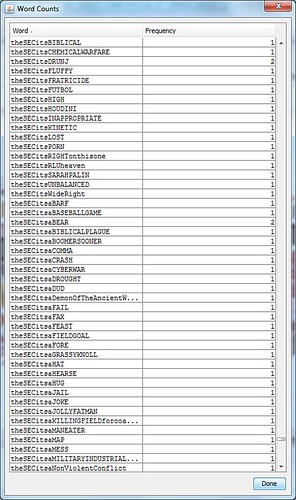[This post was originally published on The Living Room Tumblr.]
Above is a “word cloud” by Wordle, created via manipulation of the CSV file included in my personal Twitter archive, showing the 350 most frequently used words in the 79,787 tweets that I published – “new-style retweets” excluded – between August 26, 2008 and July 25, 2013. You can get a closer look here or here.
A few thoughts:
- “PANIC” is in its place of honor, exactly as you’d expect. That giant word represents 4,832 uses of “PANIC” (4,596 in all caps, 176 in all lower case, and 60 in sentence case), or roughly 3.2 #PANICs per day since my first-ever “PANIC” tweet in June 2009. (First with hashtag? Super Bowl Sunday 2010. Bonus: Tim Tebow!) And that count is without including such variations as “PANICKING” (16 uses), “PANICKED” (5) and “PANICs” (4), not to mention “PAAAAAANIC” (3), “PAAAAAAANIC” (4), and of course “PAAAAAAAAANIC” (2). Then there are the many “compound hashtags” including PANIC, from the frequently used sub-memes like “WACPANIC” (31) and “LDSPANIC” (66) to one-offs like “typoPANIC,” “trafficPANIC” and “unenforcablecontractPANIC” (1 apiece), just to name a few. If every single variation were counted, “PANIC” would be even bigger than it is. But I’d say it dominates the word cloud enough as is. 🙂
- “DOOM” is, to my mind, surprisingly small. You might not even notice it at first; it’s just a bit to the right of “@brendanloy,” in purple. Then again, I haven’t been using it as long as “PANIC.” Having basically stolen the “DOOM” meme from @CorcoranNYC just last year during his annual summer hiatus, I’ve already tweeted the word 1,149 times (all caps 845 times, no caps 266, sentence case 38). Give it another year or two, and it’ll look a lot bigger in my word cloud. That said, “DOOM” suffers, moreso than “PANIC,” from the fact that variations with extra letters go uncounted, such as “DOOOOM” (18 uses), “DOOOOOM” (38), “DOOOOOOM” (33), “DOOOOOOOM” (30), etc.
- “@brendanloy” is an unusual one; you may be wondering why I talk to myself so often? The truth, as I explained a few weeks ago to @KilroyFSU (to whom I should apparently be Twitter-gay-married, considering I’ve @mentioned him more times, 2,199, than I have my wife @MileHighBecky, 1,851), is that my handle shows up frequently in my tweets when I old-style retweet someone else’s tweet mentioning me, and then add a comment before the “RT” (often “#PANIC!” or some variation thereof). I apparently do this quite often.
- “USC” (located in between “PANIC” and “game”) is, as my Trojan tweeps will happily note, much bigger than “Notre” (right above “BREAKING”) or “Dame” (a bit southeast of “now”) or “ND” (several words north of the “S” in “@KilroyFSU”). This is partly because I always use the same term for “USC” – I virtually never call it “Southern California,” for instance – whereas I use “ND” and “Notre Dame” pretty interchangeably (as you can see).
- “Boise” (below “@MelissaTweets”) is pretty much equal size to “USC,” which is impressive, considering I have no personal connection to the place. I blame the “BCS” – which is located underneath “Boise,” appropriately enough.
- “@brando” (above “@MileHighBecky”) and “minich" (between ”@MileHighBecky" and “@kesgardner”) show up as separate entries because Wordle considers the _ character in @brando_minich’s name to constitute a word break. Heh.
- “Now” probably appears in my tweets in a lot of different contexts, but I’ll give some of the credit for its largeness to Wolf Blitzer, RIGHT NOW. “Heh,” right under it, obviously gets credited to Glenn Reynolds.
- “Obama” is way bigger than “Romney.” Ha ha. But both of them dwarf “Palin,” which is a teeny tiny word near the bottom left. (That’s largely because I didn’t really start to use Twitter regularly until well after the 2008 election.) The 387 references to “Palin” place her just barely above the cutline for inclusion in the word cloud, which seems to be around 325 or so.
Those are some of my observations offhand. What do you notice?
Incidentally, I say “350 most frequently used words,” but I should add some caveats to that. Wordle automatically excludes a bunch of extremely common words like “a” and “the,” and also excludes numbers. In addition, I manually excluded the following words (by using find & replace to delete all instances of them from my text list of tweets before I pasted that list into Wordle): RT, MT, one, just, like, and get. Without these exclusions, the word cloud would look like this:
Rather less informative, don’t you think?
I should also confess that, in constructing the word cloud, I engaged in one bit of blatant cheating. On my initial attempt, there was no reference at all to my “The SEC: it’s a WAR!!!” meme, aside from the tiny word “SEC” hidden in there somewhere. The main reason for this is that I sometimes use the full words, while other times I use compound-word hashtags (e.g., #itsaWAR or #theSECitsaWAR). Thus, there were 252 instances of “itsaWAR,” 83 instances of “theSECitsaWAR,” and 159 instances of “WAR” (counting it only when it’s in all caps) – numbers which are not quite large enough, individually, to “make the cut” (which, as I said, seems to be around 325 or so). Compounding the problem, there are many instances where I play around with the meme in all sorts of different ways, using compound hashtags to either say “[something]itsaWAR” or “theSECits[something],” as you can see from these word-count snippets:
It seemed unfair for this core Brendan Loy meme to be effectively excluded from my word cloud because of its diversity. So, as I said, I cheated. (How appropriate for the SEC. Ha! #trollin)
Again using find & replace in my textual tweet list, I put an extra space before every instance of “itsaWAR,” so that phrase would show up as a separate word even when used at the end of a compound hashtag. (There were 770 instances of the phrase, in its various contexts.) I also replaced all 88 instances of “it’s a WAR” with “itsaWAR.” And then I put a space before and after “SEC” in each instance of the phrase “theSEC” (of which there were 205).
The result is what you see above: the word “SEC” is pretty big (it’s in between “game” and “think,” right above “Denver”), and “itsaWAR” is also noticeable (below “PANIC,” in between “@brendanloy” and “@MileHighBecky”).




